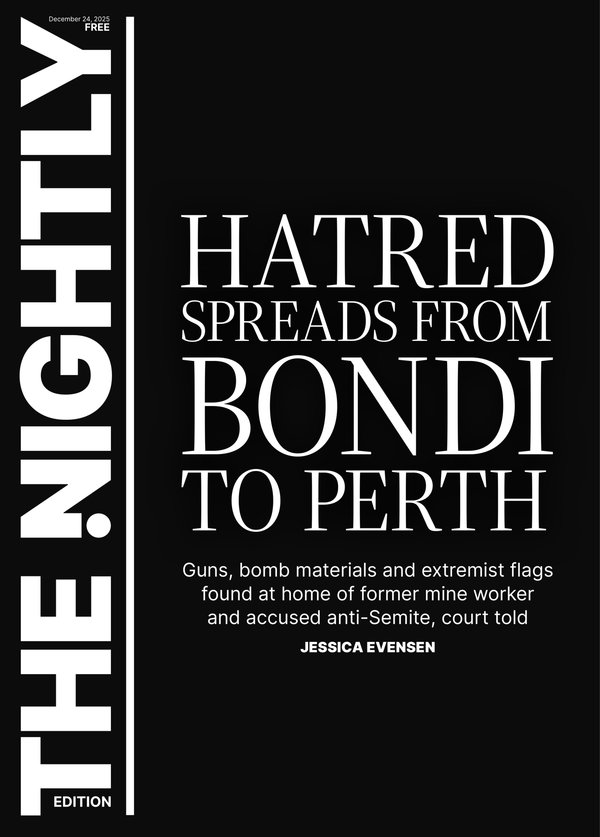Worst day for ASX in four years as $160 billion wiped off value of shares over US recession fears
The Australian share market has suffered its worst day in more than four years as rising fears of a US recession sparked global panic selling.
The benchmark S&P/ASX200 index on Monday dropped 293.6 points, or 3.7 per cent, to 7,649.6 — its biggest single day fall since May 2020.
That amounts to a loss of 5.81 per cent — or $160 billion — for the local bourse over the past two days of trading, after it finished 2.11 per cent lower on Friday.
Sign up to The Nightly's newsletters.
Get the first look at the digital newspaper, curated daily stories and breaking headlines delivered to your inbox.
By continuing you agree to our Terms and Privacy Policy.The broader All Ordinaries dropped 311 points, or 3.81 per cent, to 7,859.4.
Not since March 2020, when markets were spooked by the outbreak of the COVID-19 pandemic, has the ASX experienced such a vicious two-day sell-off.
“The markets are in meltdown and it’s a sea of red across the world,” said capital.com analyst Kyle Rodda.
Local traders joined a rout in global equities that was sparked by the US unemployment rate unexpectedly jumping to a near three-year high of 4.3 per cent on Friday.
That triggered the Sahm rule, which holds that a recession is likely underway if the three-month average of the unemployment rate rises by half a percentage point in a year.
However, NAB senior economist Taylor Nugent says it doesn’t necessarily mean the US will enter a recession, and strong growth in labour force participation will somewhat temper the rise in unemployment.
Little comfort for Japanese shareholders, who saw the Nikkei tumble by as much as 13 per cent on Monday on its worst day since 1987.
Mr Rodda said a rally in the yen after the Bank of Japan raised interest rates last week hit equities and prompted a mass deleveraging as investors sold assets to fund their losses.
“The rapidity of the move has caught a lot of investors off guard; there’s a lot of panic selling now, which is what causes these non-linear reactions in asset prices to pretty straightforward fundamental dynamics,” he said.
A positive for traders out of Monday’s carnage: it is now almost certain the Reserve Bank board will not raise the cash rate at Tuesday’s meeting.
“A lot can change seemingly overnight in the world of central banks and what we’ve seen transpire over the past week certainly speaks to this,” said T. Rowe Price portfolio manager Scott Solomon.
“Markets saw a nearly 50 per cent chance of a hike by the RBA before the end of the year get completely turned on its head, with markets now pricing nearly a 100 per cent chance of a cut before the year is out.”
After the tech-heavy Nasdaq sank 2.43 per cent on Wall Street on Friday, IT stocks led the way down on the ASX, down 6.61 per cent. The remaining 10 industrial sectors were also more than 1.5 per cent in the red.
Australia’s biggest company by market capitalisation, BHP, was down 2.1 per cent, while fellow iron miner Fortescue fell 1.9 per cent and Rio Tinto edged 0.1 per cent lower.
Traders laid waste to the Big Four banks, with CBA down 5.7 per cent, NAB falling 4.6 per cent and ANZ and Westpac both ending 4.5 per cent lower.
Oil and gas giant Woodside fell 3.6 per cent to a two-and-a-half year low of $26.48 amid reports the proposed $30 billion-plus Browse development off Western Australia failed to get state environmental approval.
Health care stocks were the least worst hit, falling 1.8 per cent.
Sleep apnoea device manufacturer ResMed was one of Monday’s few winners, up 2.9 per cent to $32.73 after reporting positive earnings results last week.
But it was not so positive for private hospital operator Ramsay Health Care, which retreated 0.3 per cent after flagging its full-year earnings, to be announced later in August, will be weaker than expected.
One Australian dollar slumped to 64.08 US cents, after buying 65.25 US cents at Friday’s ASX close.
ON THE ASX:
* The benchmark S&P/ASX200 index finished Monday down 293.6 points, or 3.7 per cent, at 7,649.6.
* The broader All Ordinaries fell 311 points, or 3.81 per cent, to 7,859.4.
CURRENCY SNAPSHOT:
One Australian dollar buys:
* 66.40 US cents, from 65.25 US cents at Friday’s ASX close
* 91.32 Japanese yen, from 97.20 Japanese yen
* 58.68 Euro cents, from 60.41 Euro cents
* 50.32 British pence, from 51.22 pence
* 108.66 NZ cents, from 109.49 NZ cents.
